Machine Learning Week_8 K-means And PCA
- 1 K-means
- 2 PCA
1 K-means
1.1 Unsupervised Learning:Introduction
In this video, I'd like to start to talk about clustering.
This will be exciting, because this is our first unsupervised learning algorithm, where we learn from unlabeled data instead from labelled data.
So, what is unsupervised learning? I briefly talked about unsupervised learning at the beginning of the class but it's useful to contrast it with supervised learning. So, here's a typical supervised learning problem where we're given a labeled training set and the goal is to find the decision boundary that separates the positive label examples and the negative label examples. So, the supervised learning problem in this case is given a set of labels to fit a hypothesis to it.
In contrast, in the unsupervised learning problem we're given data that does not have any labels associated with it. So, we're given data that looks like this. Here's a set of points add in no labels, and so, our training set is written just x1, x2, and so on up to xm and we don't get any labels y. And that's why the points plotted up on the figure don't have any labels with them. So, in unsupervised learning what we do is we give this sort of unlabeled training set to an algorithm and we just ask the algorithm find some structure in the data for us. Given this data set one type of structure we might have an algorithm find is that it looks like this data set has points grouped into two separate clusters.
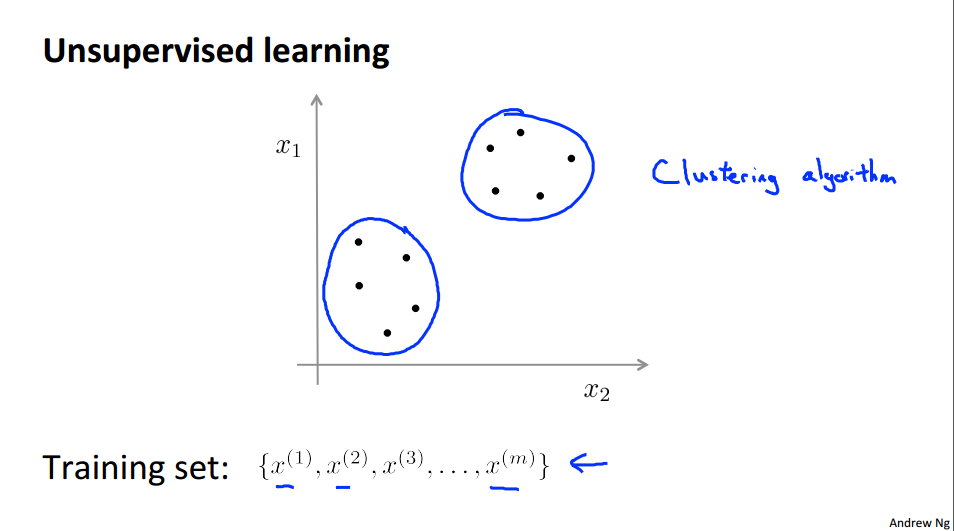
So an algorithm that finds clusters like the ones I've just circled is called a clustering algorithm. And this would be our first type of unsupervised learning, although there will be other types of unsupervised learning algorithms that we'll talk about later that finds other types of structure or other types of patterns in the data other than clusters. We'll talk about this after we've talked about clustering.
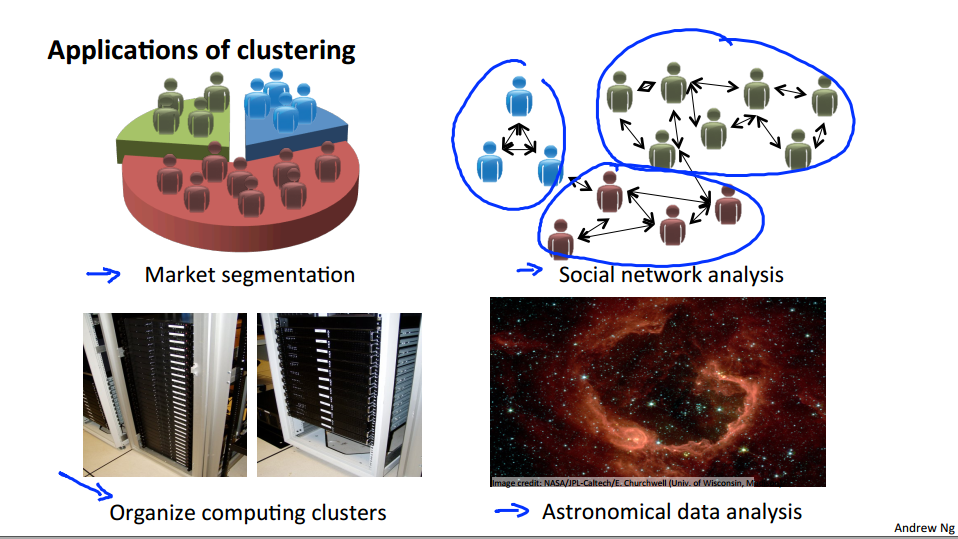
So, what is clustering good for? Early in this class I already mentioned a few applications.
One is market segmentation where you may have a database of customers and want to group them into different marker segments so you can sell to them separately or serve your different market segments better. Social network analysis. There are actually groups have done this things like looking at a group of people's social networks. So, things like Facebook, Google+, or maybe information about who other people that you email the most frequently and who are the people that they email the most frequently and to find coherence in groups of people. So, this would be another maybe clustering algorithm where you know want to find who are the coherent groups of friends in the social network? Here's something that one of my friends actually worked on which is, use clustering to organize computer clusters or to organize data centers better. Because if you know which computers in the data center in the cluster tend to work together, you can use that to reorganize your resources and how you layout the network and how you design your data center communications. And lastly, something that actually another friend worked on using clustering algorithms to understand galaxy formation and using that to understand astronomical data.
So, that's clustering which is our first example of an unsupervised learning algorithm. In the next video we'll start to talk about a specific clustering algorithm.
1.2 K-Means Algorithm
In the clustering problem we are given an unlabeled data set and we would like to have an algorithm automatically group the data into coherent subsets or into coherent clusters for us. The K Means algorithm is by far the most popular, by far the most widely used clustering algorithm.
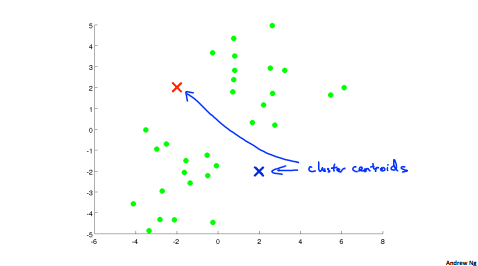 |
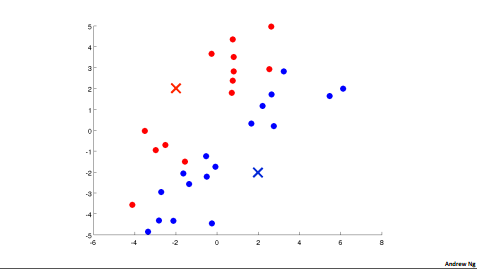 |
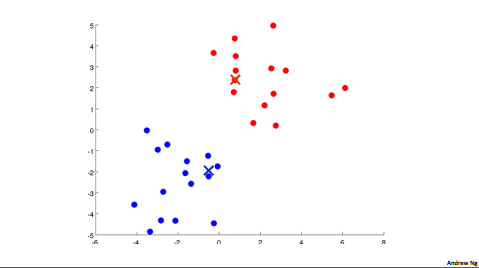 |
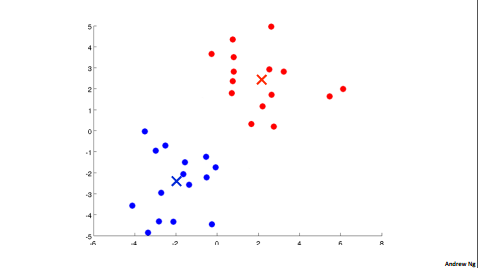 |
1.2.1 k-means algorithm
input
- K (number of clusters)
- Training set \({x^{(1)}, x^{(2)}, ..., x^{(m)}}\)
- \(x^{(i)} \in R^n\) (drop \(x_0=1\) convention)
First step:
Randomly initialize k cluster centroids \(\mu_1, \mu_2,..., \mu_k\)
\(\mu_k \in R^n\)
Second step:
repeat
{
//cluster assignment step;
//\(min_k ||x^{(1)}||\)
for i = 1 to m
\(c^{(i)}\):= Index(from 1 to k) of cluster centroid closest to x^{(i)}
//move centroid step
for k = 1 to k
// i.e. \(\mu_2 = \frac{1}{4}[x^{(1)} + x^{(2)}+x^{(5)}+x^{(6)}]\)
\(\mu_k\):= average(mean) of points assigned to clusters
}
1.3 Optimization Objective
Most of the supervised learning algorithms we've seen, things like linear regression, logistic regression, and so on, all of those algorithms have an optimization objective or some cost function that the algorithm was trying to minimize. It turns out that k-means also has an optimization objective or a cost function that it's trying to minimize. And in this video I'd like to tell you what that optimization objective is.
1.3.1 K-means optimization objective
term
\(c^{(i)}\) = index of cluster (1,2,...,k) to which eample \(x^{(i)}\) is currently assigned
\(\mu_k\) = cluster centroid k
\(\mu_{c^{(i)}}\) = cluster centroid of cluster to which example \(x^{(i)}\) has been assigned
Optimization objective
\]
\]
1.4 Random Initialization
1.4.1 Random initialzation
should have k < m
- Randomly pick k training examples.
- Set \(\mu_1 ,...,\mu_k\) equal to these k examples
Depending on the random initialzation, k-means can end up at different solutions (End up local optima)
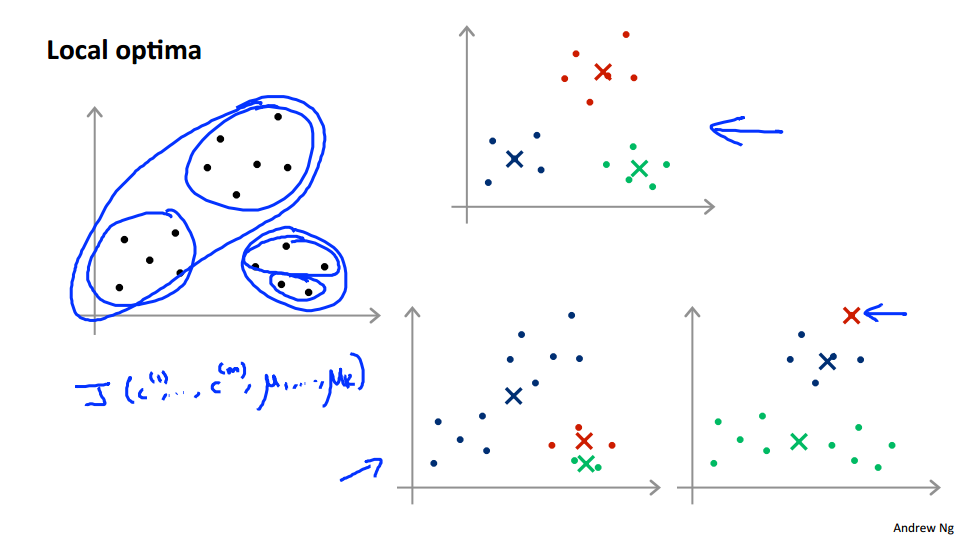
what we can do , is try multiple random initializations, and use that try to make sure we get as good solution.
1.4.2 Code
for i=1 to 100
{
Randomly initialize K-means
Run K-means. Get \(c^{(1)},...,c^{(m)},\mu_1 ,...,\mu_k\)
Compute cost function(distortation)
\(J(c^{(1)},...,c^{(m)},\mu_1,...,\mu_k) = \frac{1}{m}\sum_{i=1}^{m}||x^{(i)}-\mu_{c^{(i)}}||^2\)
}
Pick clustering that gave lowest cost J.
事实证明 \(K \in {2,3,4,..,10}\) 小聚类时,多次运行会很有好处,一旦中心数过于多,多次运行也不会有很好的优化效果。
1.5 Choosing the Number of Clusters
In this video I'd like to talk about one last detail of K-means clustering which is how to choose the number of clusters, or how to choose the value of the parameter K. To be honest, there actually isn't a great way of answering this. Doing this automatically and by far the most common way of choosing the number of clusters, is still choosing it manually by looking at visualizations or by looking at the output of the clustering algorithm or something else.
自动选择K,那么要多次挑选不同的K值,画出对应的曲线图,让我们更好的理解。像是第一张图片里的 Elbow,有一个很清晰的拐点。但有时你并不能很好的观察到这个拐点,这就是自动选择的缺点。
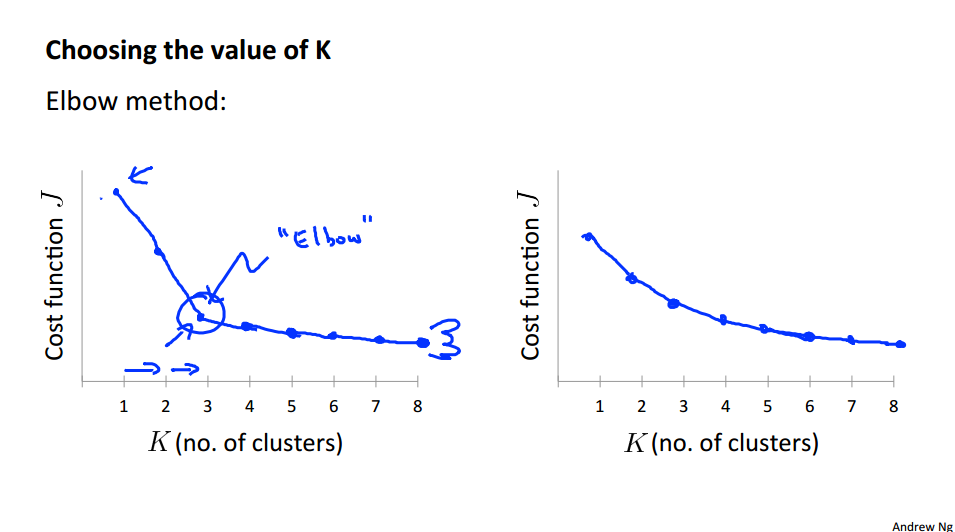
Sometimes, you're running K-means to get clusters to use for some later/downstrem purpose. Evaluate K-means based on a metric for how well it performs for that later purpose.
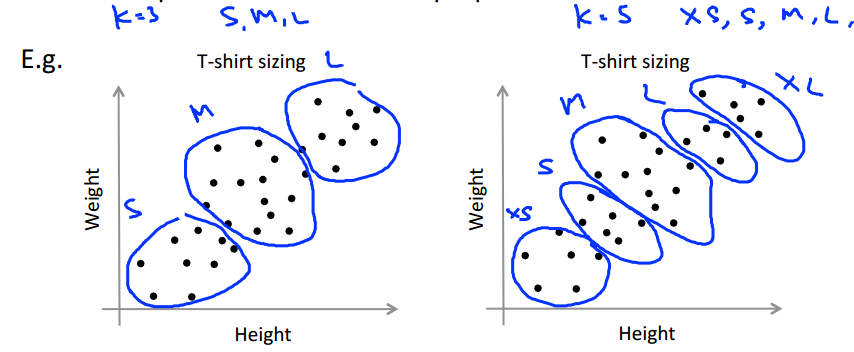
1.6 K-means with Image Compression
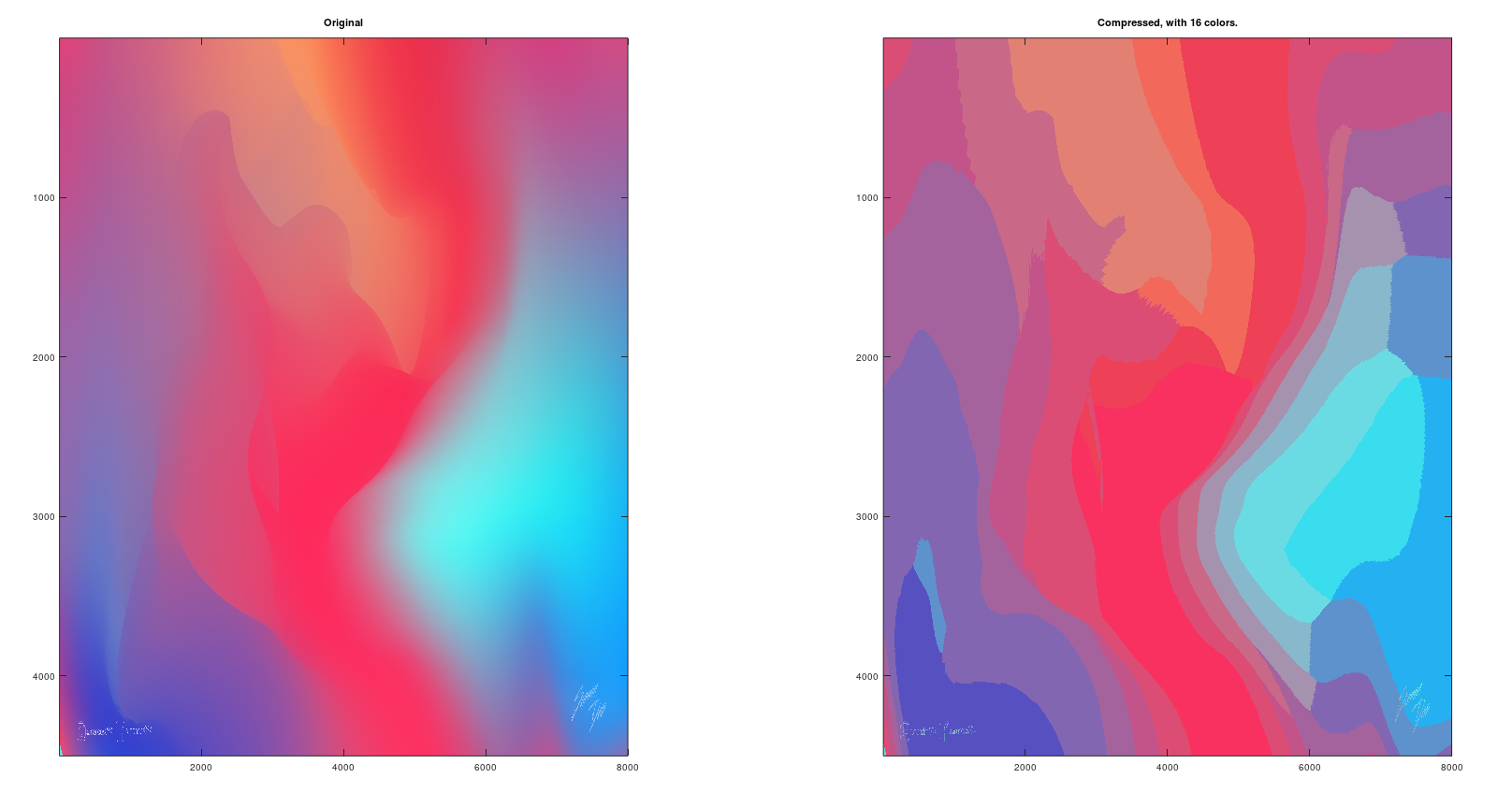
2 PCA
2.1 Motivation I: Data Compression
In this video, I'd like to start talking about a second type of unsupervised learning problem called dimensionality reduction.
There are a couple of different reasons why one might want to do dimensionality reduction. One is data compression, and as we'll see later, a few videos later, data compression not only allows us to compress the datapp and have it therefore use up less computer memory or disk space, but it will also allow us to speed up our learning algorithms.

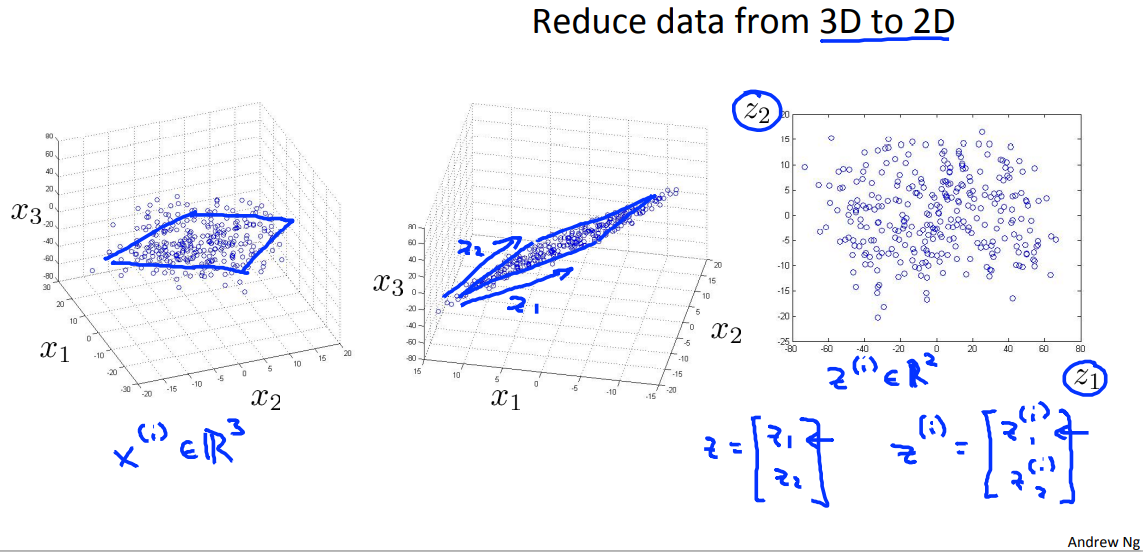
虽然是一个二维的点集(多个二维向量组成的集合), 但要找到这点集的适合的一条直线(方程 ),就可以通过一个点的位置,也就是是一个标量来确定一个二维的点。(Reduce data from 2D to 1D).
一个3维的点集,只要找到一个适合的平面,就可以通过2维向量点确定原来的3维点的位置。
2.2 Motivation II: Visualization
通常是将数据降到2D或者3D来让我们对于数据有更好的理解。
2.3 Principal Component Analysis Problem Formulation

Reudce from 2-dimention to 1-dimention: Find a direct (a vector \(u^{(1)} \in \mathbb{R}\)) onto which to project the data so as to minimize the projection error.
Reudce from 2-dimention to 1-dimention: Find k vectors \(u^{(1)},u^{(2)},...,u^{(k)}\) onto which to project the data so as to minimize the projection error.
PCA同线性回归问题不同的是, PCA的代价函数是找点到投影地的垂直距离。线性回归是预测值与实际值之间的距离。
2.4 Principal Component Analysis Algorithm
2.4.1 Feature scaling/mean nomalization
Training set:\(x^{(1)},x^{(2)},...,x^{(k)}\)
Processing(Feature scaling/mean nomalization)
\(\mu_j = \frac{1}{m} \sum^{m}_{i=1}x^{(i)}_j\)
Replace each \(x^{(i)}_j\) with \(x_j - \mu_j\)
If different features on different scales (e.g \(x_1=\) size of house, \(x_2 =\) number of bedrooms) scale features to have comparable range of values.
2.4.2 PCA
After mean normalization (ensure every feature has zero mean) and optionally feature scaling:
Compute "covariance matrix" :
\(\Sigma = \frac{1}{m} XX^T \; (X \in \mathbb{R}^{m \times n})\)
Compute “eigenvectors” of matrix \(\Sigma\):
[U, S, V] = svd(Sigma);
\(U = \begin{bmatrix} u^{(1)}& u^{(2)}& \cdots & u^{(n)} \end{bmatrix} \; (U \in \mathbb{R}^{n \times n})\)
 |
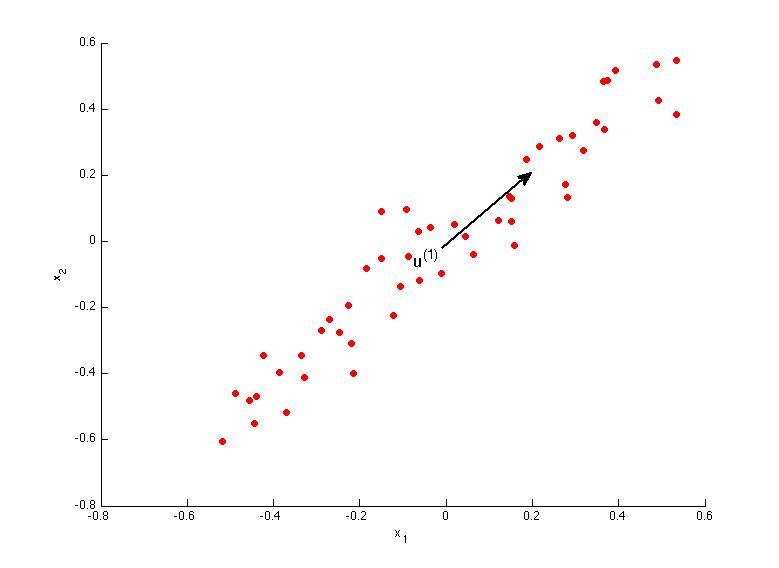 |
Ureduce = U(:,i:k)
Z = X * U(:,i:k)
2.5 Reconstruction from Compressed Representation
In some of the earlier videos, I was talking about PCA as a compression algorithm where you may have say, 1,000-dimensional data and compress it to 100-dimensional feature vector. Or have three-dimensional data and compress it to a two-dimensional representation. So, if this is a compression algorithm, there should be a way to go back from this compressed representation back to an approximation of your original high-dimensional data. So given \(z^{(i)}\), which may be 100-dimensional, how do you go back to your original representation, \(x^{(i)}\) or \(x_{approx}^{(i)}\) which was maybe a 1000-dimensional.
X_rec = Z * U(:, 1:k)`
2.6 Choosing the Number of Principal Components
Average squared projection error: \(\frac{1}{m} \sum^{m}_{i=1}||x^{(i)} - x_{approx}^{(i)}\;||^2\)
Total variation in the data: \(\frac{1}{m} \sum^{m}_{i=1} ||x^{(i)}||^2\)
Typically , choose \(k\) to be smallest value so that:
\]
We can say that 99% variance retained instead.
这里还有另一种简单的方法来代替上面的方法。利用到了SVD()函数返回的S矩阵。
s_{11}& 0 & \cdots & 0\\
0 & s_{22} & \cdots & 0\\
\vdots & 0 & \ddots & 0\\
0 & 0 & \cdots & s_{nn}\\
\end{bmatrix} \; (S \in \mathbb{R}^{n \times n})\]
Choose \(k\) to be smallest value so that:
\]
We can say that 99% variance retained
2.7 Advice for Applying PCA
2.2.1 Supervised learning speedup
If we have a training data set \({(x^{(1)},y^{(1)}), (x^{(2)},y^{(2)}), ..., (x^{(m)},y^{(m)})}\).
We can extract inputs to unlabled data which \(x^{(1)},x^{(2)}, ...,x^{(m)} \in \mathbb{R^{10000}}\). Using PCA alogrithem to reudce the data from n-dimention to k-dimention. After that we get \({z^{(1)},z^{(2)}, ...,z^{(m)} \in \mathbb{R^{1000}}}\).
Thus we have a new training set \((z^{(1)},y^{(1)}), (z^{(2)},y^{(2)}), ..., (z^{(m)},y^{(m)})\) to speed up the learning algorithm. Also this operation can reduce memory/disk needed to store data.
Note: Mapping \(x^{(i)} \rightarrow z^{(i)}\)should be defined by running PCA only on the training set. This mapping can be applied as well to the examples \(x^{(i)}_{cv}\) and \(x^{(i)}_{test}\) in the cross valida1on and test sets. Test on test set: Map \(x^{(i)}_{test}\) to \(z^{(i)}_{test}\). Run \(h_\theta (z^{(i)})\) on \((z^{(1)}_{test},y^{(1)}_{test}), (z^{(2)}_{test},y^{(2)}_{test}), ..., (z^{(m)}_{test},y^{(m)}_{test})\).
2.7.2 PCA is sometimes used where it shouldn’t be.
One of the bad use of PCA is that to prevent the overfitting. Use \(z^{(i)}\) instead of \(x^{(i)}\) to reduce the number of features to \(k<n\). Thus fewer features less likely to overfit.
This might work OK but isn't a good way to address overfitting.
Use regularization instead.
\]
\]
Hint: Before implemen1ng PCA first try running whatever you want to do with the original/raw data \(X\) . Only if that doesn't do what you want then implement PCA and consider using \(Z\) .
Machine Learning Week_8 K-means And PCA的更多相关文章
- OpenCV Machine Learning 之 K近期邻分类器的应用 K-Nearest Neighbors
OpenCV Machine Learning 之 K近期邻分类器的应用 以下的程序实现了对高斯分布的点集合进行分类的K近期令分类器 #include "ml.h" #includ ...
- Getting started with machine learning in Python
Getting started with machine learning in Python Machine learning is a field that uses algorithms to ...
- 机器学习实战(Machine Learning in Action)学习笔记————09.利用PCA简化数据
机器学习实战(Machine Learning in Action)学习笔记————09.利用PCA简化数据 关键字:PCA.主成分分析.降维作者:米仓山下时间:2018-11-15机器学习实战(Ma ...
- 另一种压缩图片的方法---Machine learning 之 PCA(Principle Component Analysis)
PCA最主要的用途是用来减少特征向量的数目,N个特征向量 减小到 K个特征向量.如果为了可视化,k可以使3 或者 2.这样可以加速算法的学习速度. PCA用来压缩图像同一有效. 具体方式以及原理在gi ...
- K近邻 Python实现 机器学习实战(Machine Learning in Action)
算法原理 K近邻是机器学习中常见的分类方法之间,也是相对最简单的一种分类方法,属于监督学习范畴.其实K近邻并没有显式的学习过程,它的学习过程就是测试过程.K近邻思想很简单:先给你一个训练数据集D,包括 ...
- Machine Learning for Developers
Machine Learning for Developers Most developers these days have heard of machine learning, but when ...
- How do I learn machine learning?
https://www.quora.com/How-do-I-learn-machine-learning-1?redirected_qid=6578644 How Can I Learn X? ...
- How do I learn mathematics for machine learning?
https://www.quora.com/How-do-I-learn-mathematics-for-machine-learning How do I learn mathematics f ...
- Machine Learning and Data Mining(机器学习与数据挖掘)
Problems[show] Classification Clustering Regression Anomaly detection Association rules Reinforcemen ...
- Course Machine Learning Note
Machine Learning Note Introduction Introduction What is Machine Learning? Two definitions of Machine ...
随机推荐
- pyglet.gl.ContextException: Could not create GL context
参考: https://www.saoniuhuo.com/question/detail-2725960.html ========================================= ...
- Redis源码安装(Linux环境)
下载源码: wget https://download.redis.io/redis-stable.tar.gz 解压: tar -xzvf redis-stable.tar.gz 编译&安装 ...
- Centos7安装mysql8.0教程
1.背景 centos7安装mysql8.0 2.安装步骤 步骤一:安装准备工作 1.查看是否有安装过mysql rpm -qa | grep -i mysql 2.删除mysql yum -y re ...
- Spring AI 更新:支持OpenAI的结构化输出,增强对JSON响应的支持
就在昨晚,Spring AI发了个比较重要的更新.由于最近OpenAI推出了结构化输出的功能,可确保 AI 生成的响应严格遵守预定义的 JSON 模式.此功能显着提高了人工智能生成内容在现实应用中的可 ...
- DRM:清华提出无偏差的新类发现与定位新方法 | CVPR 2024
论文分析了现有的新类别发现和定位(NCDL)方法并确定了核心问题:目标检测器往往偏向已知的目标,忽略未知的目标.为了解决这个问题,论文提出了去偏差区域挖掘(DRM)方法,以互补的方式结合类无关RPN和 ...
- 使用jquery的tmpl构建复杂表格
Tmpl提供了几种tag:${}:等同于{{=}},是输出变量,通过了html编码的.{{html}}:输出变量html,但是没有html编码,适合输出html代码.{{if }} {{else}}: ...
- Linux/Go环境搭建, HelloWorld运行
package main import "fmt" func main() { fmt.Printf("Hello,World!!!\n") } 以上是Go语言 ...
- layui表格中格式化日期
layui表格中格式化日期 //1.引入 util layui.use(['table', 'admin'], function () { var util = layui.util; //2.表格内 ...
- ubuntu 16.04 安装Python3.8虚拟环境
virtualenv为应用提供了隔离的Python运行环境,可以解决不同应用间多版本的冲突问题. virtualenv会把用户指定版本的python复制到虚拟环境下,并修改相关的环境变量,使得pyth ...
- spring boot使用多数据源体验
小白是一名.net程序员,之前小白介绍了过了自己的博客系统http://www.ttblog.site/,用.net写厌了,所以想学下java尝尝鲜,于是小白准备用spring boot来实现一个博客 ...
